
Sir John Betjeman, was an English poet, writer, and broadcaster. He was Poet Laureate from 1972 until his death. He was a founding member of The Victorian Society and a passionate defender of Victorian architecture, helping to save St Pancras railway station from demolition. He began his career as a journalist and ended it as one of the most popular British Poets Laureate and a much-loved figure on British television.

St Pancras railway station, officially known since 2007 as London St Pancras International, is a major central London railway terminus on Euston Road in the London Borough of Camden. It is the terminus for Eurostar services from Belgium, France and the Netherlands to London. It provides East Midlands Railway services to Leicester, Corby, Derby, Sheffield and Nottingham on the Midland Main Line, Southeastern high-speed trains to Kent via Ebbsfleet International and Ashford International, and Thameslink cross-London services to Bedford, Cambridge, Peterborough, Brighton, Horsham and Gatwick Airport. It stands between the British Library, the Regent's Canal and London King's Cross railway station, with which it shares a London Underground station, King's Cross St Pancras.

Wembley Park is a London Underground station in Wembley Park, north-west London. It is served by the Jubilee and Metropolitan lines and is in Travelcard Zone 4. On the Jubilee line the station is between Kingsbury and Neasden stations, and on the Metropolitan line it is between Preston Road and Finchley Road stations. It is located on Bridge Road (A4089) and is the nearest Underground station to exit for Wembley Stadium and Wembley Arena. This is where the Jubilee line from Stanmore diverges from the Metropolitan line, which was formerly a branch of the Metropolitan Railway and was taken over by the Bakerloo line and is now part of the Jubilee line.

Watkin's Tower was a partially completed iron lattice tower in Wembley Park, London, England. Its construction was an ambitious project to create a 358-metre (1,175 ft)-high visitor attraction in Wembley Park to the north of the city, led by the railway entrepreneur Sir Edward Watkin. Marketed as the "Great Tower of London", it was designed to surpass the height of the Eiffel Tower in Paris, and it was part of Wembley Park's emergence as a recreational place. The tower was never completed and it was demolished in 1907. The site of the tower is now occupied by the English national football ground, Wembley Stadium.

The Titfield Thunderbolt is a 1953 British comedy film directed by Charles Crichton and starring Stanley Holloway, Naunton Wayne, George Relph and John Gregson. The screenplay concerns a group of villagers trying to keep their branch line operating after British Railways decided to close it. The film was written by T. E. B. Clarke and was inspired by the restoration of the narrow gauge Talyllyn Railway in Wales, the world's first heritage railway run by volunteers. "Titfield" is an amalgamation of the names Titsey and Limpsfield, two villages in Surrey near Clarke's home at Oxted.

Marlborough Road is a disused London Underground station in St John's Wood, northwest London NW8, England. It opened in April 1868 on the Metropolitan & St. John's Wood Railway, the first northward extension from Baker Street of the Metropolitan Railway. It is located at the junction of Finchley Road and Queen's Grove.
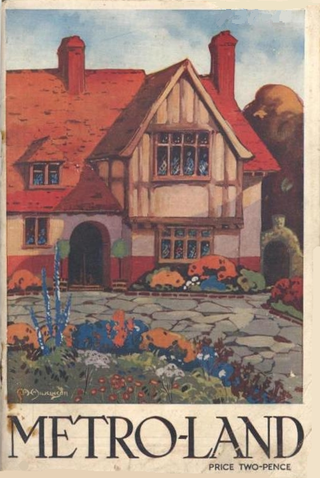
Metro-land is a name given to the suburban areas that were built to the north-west of London in the counties of Buckinghamshire, Hertfordshire and Middlesex in the early part of the 20th century that were served by the Metropolitan Railway ( ). The railway company was in the privileged position of being allowed to retain surplus land; from 1919 this was developed for housing by the nominally independent Metropolitan Railway Country Estates Limited (MRCE). The term "Metro-land" was coined by the Met's marketing department in 1915 when the Guide to the Extension Line became the Metro-land guide. It promoted a dream of a modern home in beautiful countryside with a fast railway service to central London until the Met was absorbed into the London Passenger Transport Board in 1933.

King's Lynn railway station is the northern terminus of the Fen line in the east of England, serving the town of King's Lynn, Norfolk. It is 41 miles 47 chains (66.9 km) from Cambridge and 96 miles 75 chains (156.0 km) measured from London Liverpool Street.

Evercreech Junction was a railway station at Evercreech on the Somerset and Dorset Joint Railway.

Candida Rose Lycett Green was a British author who wrote sixteen books including English Cottages, Goodbye London, The Perfect English House, Over the Hills and Far Away and The Dangerous Edge of Things. Her television documentaries included The Englishwoman and the Horse, and The Front Garden. Unwrecked England, based on a regular column of the same name she wrote for The Oldie from 1992, was published in 2009.

Pershore railway station serves both the town of Pershore and village of Pinvin in Worcestershire, England. The station is on a single-track section of the Cotswold Line. The station, and all trains serving it, are operated by Great Western Railway.
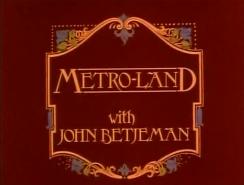
Metro-land is a BBC documentary film written and narrated by the Poet Laureate of the United Kingdom, Sir John Betjeman. The film was directed by Edward Mirzoeff, and first broadcast on 26 February 1973. The film celebrates suburban life in the area to the northwest of London that grew up in the early 20th century around the Metropolitan Railway (MR), later the Metropolitan line of the London Underground.
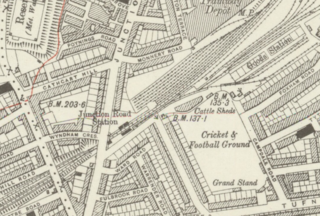
Junction Road railway station was a railway station in London (1872–1943). The station was opened by the Tottenham and Hampstead Junction Railway.

Wadebridge railway station was a railway station that served the town of Wadebridge in Cornwall, England. It was on the Bodmin and Wadebridge Railway.
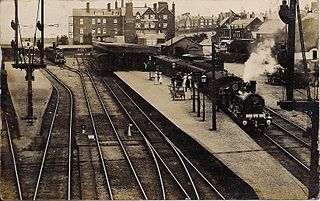
Hunstanton railway station served the seaside town of Hunstanton in Norfolk, England. Opened in 1862, the station was the northern terminus of the Lynn and Hunstanton Railway. The line was brought to public notice by John Betjeman in the British Transport Film John Betjeman Goes By Train. The station closed with the line in 1969.
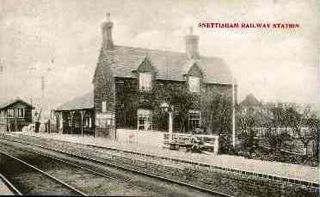
Snettisham was a railway station on the King's Lynn to Hunstanton line which served the village of Snettisham, a few miles north of King's Lynn in North Norfolk, England. Opened in 1862, the station closed along with the line in 1969.

Sir John Betjeman (1906–1984) was a twentieth-century English poet, writer and broadcaster. Born to a middle-class family in Edwardian Hampstead, he attended Oxford University, although left without graduating. He turned down a position in the family furniture business, and instead took a series of jobs before becoming the assistant editor of The Architectural Review in 1931, which reflected a deeply held affection for buildings and their history. That same year he published his first book, Mount Zion, a collection of poems.

A Passion for Churches is a 1974 BBC television documentary written and presented by the then Poet Laureate Sir John Betjeman and produced and directed by Edward Mirzoeff. Commissioned as a follow-up to the critically acclaimed 1973 documentary Metro-land, the film offers Betjeman's personal poetic record of the various rituals taking place throughout the Anglican Diocese of Norwich and its churches in the run-up to Easter Sunday using the framing device of the Holy sacraments.
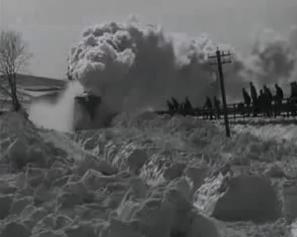
Snowdrift at Bleath Gill is a 1955 British Transport Film documentary directed by Kenneth Fairbairn. The 10-minute-long film presents a first-hand account of a team of British Railways workmen freeing a goods train stuck in a snowdrift on the South Durham and Lancashire Union Railway at Bleath Gill in the Pennines on the border between County Durham, Yorkshire and Westmoreland. A fine example of an industrial documentary, the British Film Institute call it "One of the most outstanding films of its kind".

The statue of John Betjeman at St Pancras railway station, London is a depiction in bronze by the sculptor Martin Jennings. The statue was designed and cast in 2007 and was unveiled on 12 November 2007 by Betjeman's daughter, Candida Lycett Green and the then Poet Laureate Andrew Motion to commemorate Betjeman and mark the opening of St Pancras International as the London terminus of the Eurostar high-speed rail link between Great Britain and mainland Europe. The location memorialises the connection between St Pancras station and Betjeman, an early and lifelong advocate of Victorian architecture who led the campaign to save the station from demolition in the 1960s.



















